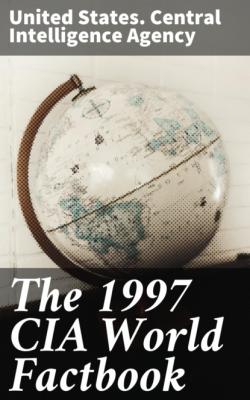The 1997 CIA World Factbook. United States. Central Intelligence Agency
Чтение книги онлайн.
Читать онлайн книгу The 1997 CIA World Factbook - United States. Central Intelligence Agency страница 39
 definition : age 15 and over can read and write total population: 99% (1974 est.) male: NA% female: NA%
definition : age 15 and over can read and write total population: 99% (1974 est.) male: NA% female: NA%
@Austria:Government
Country name: conventional long form : Republic of Austria conventional short form: Austria local long form: Republik Oesterreich local short form: Oesterreich
Data code: AU
Government type: federal republic
National capital: Vienna
Administrative divisions: 9 states (Bundeslaender, singular -
Bundesland); Burgenland, Kaernten, Niederoesterreich, Oberoesterreich,
Salzburg, Steiermark, Tirol, Vorarlberg, Wien
Independence: 1156 (from Bavaria)
National holiday: National Day, 26 October (1955)
Constitution: 1920; revised 1929 (reinstated 1 May 1945)
Legal system: civil law system with Roman law origin; judicial review of legislative acts by the Constitutional Court; separate administrative and civil/penal supreme courts; has not accepted compulsory ICJ jurisdiction
Suffrage: 18 years of age; universal; compulsory for presidential elections
Executive branch: chief of state: President Thomas KLESTIL (since 8 July 1992) head of government: Chancellor Viktor KLIMA (since 28 January 1997); Vice Chancellor Wolfgang SCHUESSEL (since 22 April 1995) cabinet: Council of Ministers chosen by the president on the advice of the chancellor elections : president elected by popular vote for a six-year term; presidential election last held 24 May 1992 (next to be held NA 1998); chancellor chosen by the president from the majority party in the National Council; vice chancellor chosen by the president on the advice of the chancellor election results: Thomas KLESTIL elected president; percent of vote, second ballot - Thomas KLESTIL 57%, Rudolf STREICHER 43%
Legislative branch: bicameral Federal Assembly or Bundesversammlung consists of Federal Council or Bundesrat (63 members; members represent each of the provinces on the basis of population, but with each province having at least three representatives) and the National Council or Nationalrat (183 seats; members elected by direct popular vote to serve four-year terms) elections: National Council - last held 17 December 1995 (next to be held Fall 1999) election results : National Council - percent of vote by party - SPOe 38.3%, OeVP 28.3%, FPOe 22.1%, Greens 4.6%, LF 5.3%, other 1.4%; seats by party - SPOe 71, OeVP 53, FPOe 40, Greens 9, LF 10
Judicial branch: Supreme Judicial Court or Oberster Gerichtshof; Administrative Court or Verwaltungsgerichtshof; Constitutional Court or Verfassungsgerichtshof
Political parties and leaders: Social Democratic Party of Austria or
SPOe [Viktor KLIMA, chairman]; Austrian People's Party or OeVP
[Wolfgang SCHUESSEL, chairman]; Freedom Movement or FPOe (formerly the
Freedom Party of Austria or FPOe [Joerg HAIDER, chairman]; Communist
Party or KPOe [Walter SILBERMAYER, chairman]; The Greens [Madeleine
PETROVIC]; Liberal Forum or LF [Heide SCHMIDT]
Political pressure groups and leaders: Federal Chamber of Trade and Commerce; Austrian Trade Union Federation (primarily Socialist) or OeGB; three composite leagues of the Austrian People's Party or OeVP representing business, labor, and farmers; OeVP-oriented League of Austrian Industrialists or VOeI; Roman Catholic Church, including its chief lay organization, Catholic Action
International organization participation: AfDB, AG (observer), AsDB,
Australia Group, BIS, CCC, CE, CEI, CERN, EBRD, ECE, EIB, ESA, EU,
FAO, G- 9, IADB, IAEA, IBRD, ICAO, ICC, ICFTU, ICRM, IDA, IEA, IFAD,
IFC, IFRCS, ILO, IMF, IMO, Intelsat, Interpol, IOC, IOM, ISO, ITU,
MINURSO, MTCR, NACC (observer), NAM (guest), NEA, NSG, OAS (observer),
OECD, OSCE, PCA, PFP, UN, UNCTAD, UNDOF, UNESCO, UNFICYP, UNHCR,
UNIDO, UNIKOM, UNITAR, UNMIBH, UNMOT, UNOMIG, UNTSO, UPU, WCL, WEU
(observer), WFTU, WHO, WIPO, WMO, WToO, WTrO, ZC
Diplomatic representation in the US: chief of mission: Ambassador Helmut TUERK chancery : 3524 International Court NW, Washington, DC 20008–3035 telephone: [1] (202) 895–6700 FAX: [1] (202) 895–6750 consulate(s) general: Chicago, Los Angeles, and New York
Diplomatic representation from the US: chief of mission: Ambassador Swanee G. HUNT embassy: Boltzmanngasse 16, A-1091, Vienna mailing address: use embassy street address telephone : [43] (1) 313–39 FAX: [43] (1) 310–0682
Flag description: three equal horizontal bands of red (top), white, and red
Economy
Economy - overview: Austria has a well-developed market economy with a sizable - but falling - proportion of nationalized industry, an extensive social safety net, and a high standard of living. Austria's economy is closely integrated with Germany and other EU members - Austria joined the EU on 1 January 1995. Since the early 1980s, the Austrian economy has experienced stable growth. EU membership has had a positive impact on foreign investment and has helped to lower inflation. In April 1996, the government passed a two-year austerity budget - including cuts in social allowances, a freeze on civil servants' wages, and new energy and capital gains taxes - designed to bring the economy in line with the Maastricht criteria for membership in the European Economic and Monetary Union (EMU). EMU convergence has become a top priority for Austria. Despite Austria's generally favorable prospects, the economy faces a number of medium-term challenges; for example, fiscal tightening is constraining expected growth, and unemployment is expected to increase.
GDP: purchasing power parity - $157.6 billion (1996 est.)
GDP - real growth rate: 1.1% (1996 est.)
GDP - per capita: purchasing power parity - $19,700 (1996 est.)
GDP - composition by sector: agriculture: 3% industry: 27% services : 70% (1994 est.)
Inflation rate - consumer price index: 1.8% (1996 est.)
Labor force: total: 3.648 million (1996) by occupation: services 56.4%, industry and crafts 35.4%, agriculture and forestry 8.1% note : an estimated 200,000 Austrians are employed in other European countries; foreign laborers in Austria number 177,840, about 5% of labor force (1988)
Unemployment rate: 6.2% (December 1996)
Budget: revenues: $61.2 billion expenditures: $71 billion, including capital expenditures of $NA
Industries: food, iron and steel, machines, textiles, chemicals, electrical, paper and pulp, tourism, mining, motor vehicles
Industrial production growth rate: 0.6% (1996 est.)
Electricity - capacity: 17.43 million kW (1994)
Electricity - production: 56.5 billion kWh (1995)
Electricity - consumption per